Authored by Hamed Taherdoost*,
Abstract
PROMETHEE (Preference Ranking Organization Method for Enrichment Evaluation) is one of the main MCDM methods helping decision-makers to investigate a set of alternatives considering different criteria. This method is particularly useful when the decision-makers need to compare a set of alternatives based on multiple criteria. The PROMETHEE method has been applied in various fields, including business, finance, hydrology, and water management. In business, for instance, PROMETHEE can be used to evaluate different investment opportunities based on various criteria such as return on investment, risk, and strategic fit. In water management, PROMETHEE can be used to evaluate alternative strategies for water allocation or pollution control, considering factors such as environmental impact, cost, and social acceptability. Different versions of PROMETHEE have been developed, each with its own specific characteristics and requirements. This paper describes the steps of the PROMETHEE I and II procedures, which are among the most widely used versions of the method. The PROMETHEE I procedure is used for ranking alternatives based on a single criterion, while PROMETHEE II is used for ranking alternatives based on multiple criteria.
Introduction
Decision-making is a crucial aspect of human existence. All of these choices are evaluated against each other, often based on the decision maker’s preferences, past experiences, and other information at hand. Technically, a decision may be described as an action plan intended to address a particular decision issue or a choice made in light of the facts at hand [1]. It should be noted that it is now generally accepted to extend the procedure of decision support beyond the classical framework of single-goal optimization detailed on the set of acceptable solutions [2], considering the systematics of the decision situation itself and the classical framework of single criterion optimization. This addition enables one to approach multi-criteria issues with an emphasis on finding a solution that sufficiently balances a wide range of often-at-odds objectives [3,4]. The decision-making process needs to always be included when discussing any choice. A complicated brain process called decision-making seeks to find a desired outcome while taking many factors into account. This process may be illogical or logical, and on the other hand, it may make explicit or implicit assumptions that are impacted by a variety of elements, including social, cultural, biological, and physiologic influences. Any of these factors, together with authority and risk levels, may influence how difficult a decision-making process is. Nowadays, economic theories, computer tools, algebra, mathematical equations, and a variety of statistics that automatically calculate and estimate the answers to decision-making questions may be used to solve complicated decision-making difficulties [5].
Manifold criteria and alternatives must be considered to evaluate a complex decision-making problem. For this, different multi-criteria decision aid (MCDA) methods can be used to support decision-makers in different fields. During the last decades, these methods are between fast-growing fields of operational research. These methods can be used for several application areas such as business, management, engineering, etc. Several MCDA methods are developed that PROMETHEE (Preference Ranking Organization Method for enrichment evaluation) family are among the main techniques that can assist to evaluate the criteria in both qualitative and quantitative ways [6]. This method was introduced first by Brans (Brans, 1982) in 1982, and further was extended by Vincke and Brans in 1985 [7]. The main pillars of this method are:
1. Enriching the preference structure with several functions for preference, and the dominance relation of the alternatives (considering each criterion).
2. Decision aiding as a result of partial/complete rankings [6].
Similar to ELECTRE, PROMETHEE is an outranking method that uses several iterations to gain the ranking between a finite alternative set. The ranking process (both conception and application) is very simple compared with other multi-criteria decision making (MCDM) methods that this point results in increasing the number of decision-makers who used this method to address their complex problems year by year. Also, many researchers investigate the sensitive aspects of this method in their studies [7]. In this method, different preference functions can be used based on the characteristics of the criteria that are used to eliminate the scaling effect of the criteria. This point is the main merit of the PROMETHEE method. The preference function as well as the threshold values used in the PROMETHEE process should be selected based on the perspectives of the decision-makers for each specific problem [6].
The family of the PROMETHEE method includes several techniques. First, PROMETHEE I, and II were developed for partial and complete ranking; respectively. Then, other versions were introduced. For example, PROMETHEE III is used for ranking based on intervals. The PROMETHEE IV is used when the decision-makers face a continuous set of viable solutions for both partial and complete ranking, and the problems that include segmentation constraints can be addressed by the PROMETHEE V method. The other version known as the PROMETHEE VI, GDSS, and GAIA (Geometrical Analysis for Interactive Aid) can be used for the representation of the human brain, group decision making, and graphical representation; respectively. The GAIA is a visual interactive module that can be used when the decision problem is very complicated. Also, the most recent versions, PROMETHEE TRI and CLUSTER are developed for sorting problems and nominal classification; respectively. All these versions are successful MCDM methods according to their userfriendly form and mathematical properties [7]. The next sections are provided to represent the application areas, advantages, and disadvantages of the PROMETHEE methods more specifically. The final section also introduces the process steps and algorithms of the PROMETHEE I and II methods briefly.
Application Areas
In recent years, there has been a noticeable increase in the number of unusual crises. Not only do these occurrences impede the growth of the economy and society, but they also constitute a significant risk to the stability of human means of subsistence. As a result, given the current circumstances, it is essential to place an emphasis on enhancing the capacities of emergency management organizations and minimizing the negative impacts that are brought on by calamities. Since the circumstances surrounding emergency decision-making are prone to variation, risk, and uncertainty, it is necessary to devise a variety of emergency management strategies that may be applied to a wide range of scenarios. An important issue that requires prompt resolution is determining, from among several potential options, which course of action will provide the best results [8].
The asymmetry and complexity of big group decision problems, as well as the differences in the decision makers’ own knowledge level, life experience, and research direction, all contribute to the fact that it is difficult for decision-makers to make accurate assessments of decision options when they are under the time pressure of the decision process. Traditional decision problems do not have these characteristics [8]. The PROMETHEE methods have manifold application areas ranging from environmental management to business, finance, hydrology, and water management [9]. Behzadian, et al. proposed a detailed review of application areas of the PROMETHEE. They categorized the studies that used this decision-making method into nine different subgroups. They recognized “Environment Management” as the most popular application area among the sub-categories. The results of this comprehensive literature review on the application areas of the PROMETHEE are summarized in Table 1, to give you a better overview.
Table 1: PROMETHEE Application Areas [7].
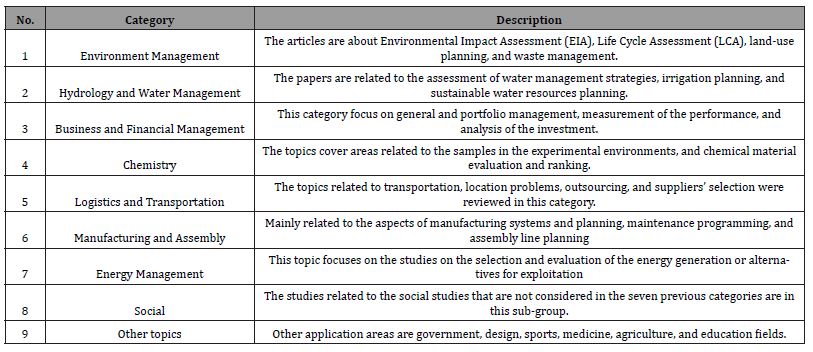
Advantages and Disadvantages
The PROMETHEE method like other MCDM methods offers many advantages for the decision-making processes, for example, according to the literature the main merit of this method is the easy-to-use and simple outranking process. Although, the demerits are negligible. The disadvantages can be overcome by using hybrid and integrated PROMETHEE-based models [6]. In this section, the main advantages and disadvantages are listed in Table 2 [1,9,10].
Table 2: Advantages and disadvantages of the PROMETHEE Methods.
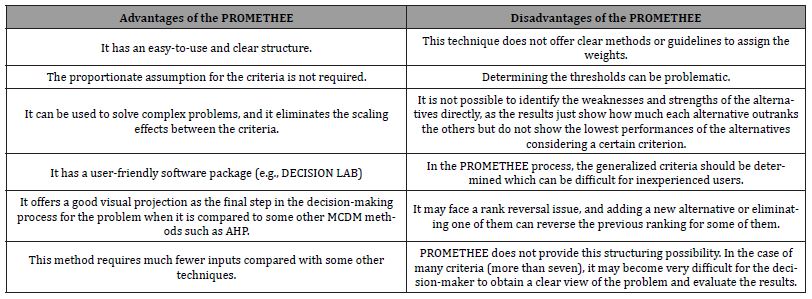
Process Steps of the PROMETHEE I Method (Partial Ranking)
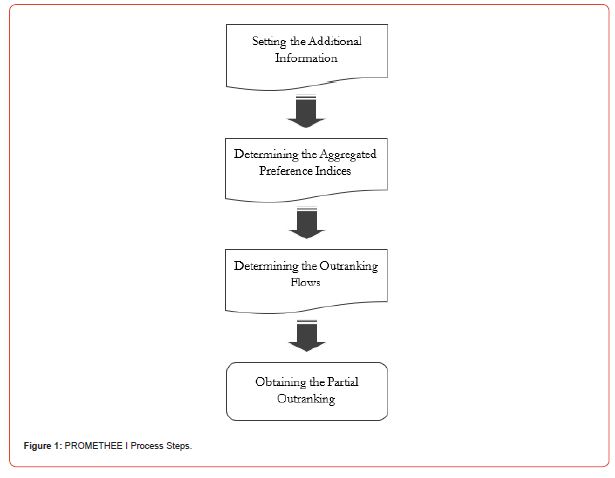
The information is provided by an appropriate MCDM method using pairwise comparison to determine the weather.

Of course, the aim of these methods is to minimize the number of incompatibilities between pairs of alternatives as much as possible, but it is also important to be realistic in this regard as eliminating all incompatibilities can make the decision-making process more disputable. The PROMETHEE methods belong to the outranking family of MCDM methods and work based on pairwise comparison. The process steps of the PROMETHEE method are shown in (Figure 1).
Step 1: Setting the Additional Information
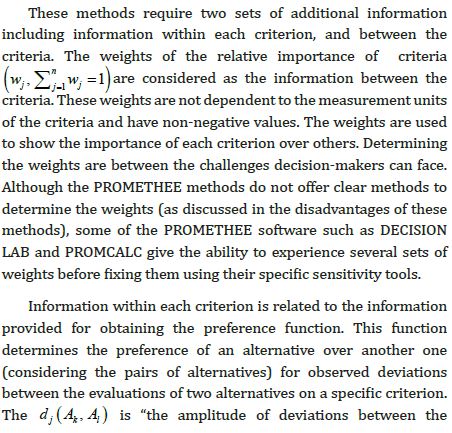
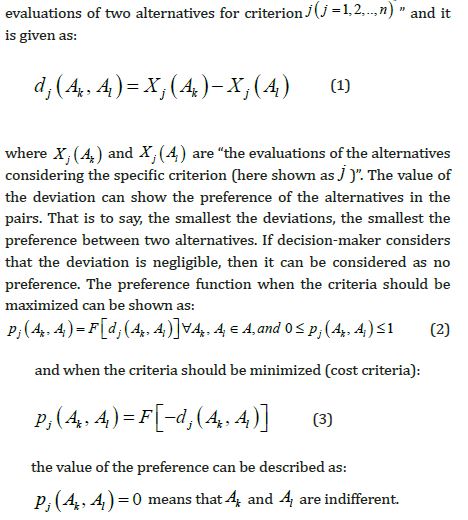

Table 3: The Generalized Criteria [6].
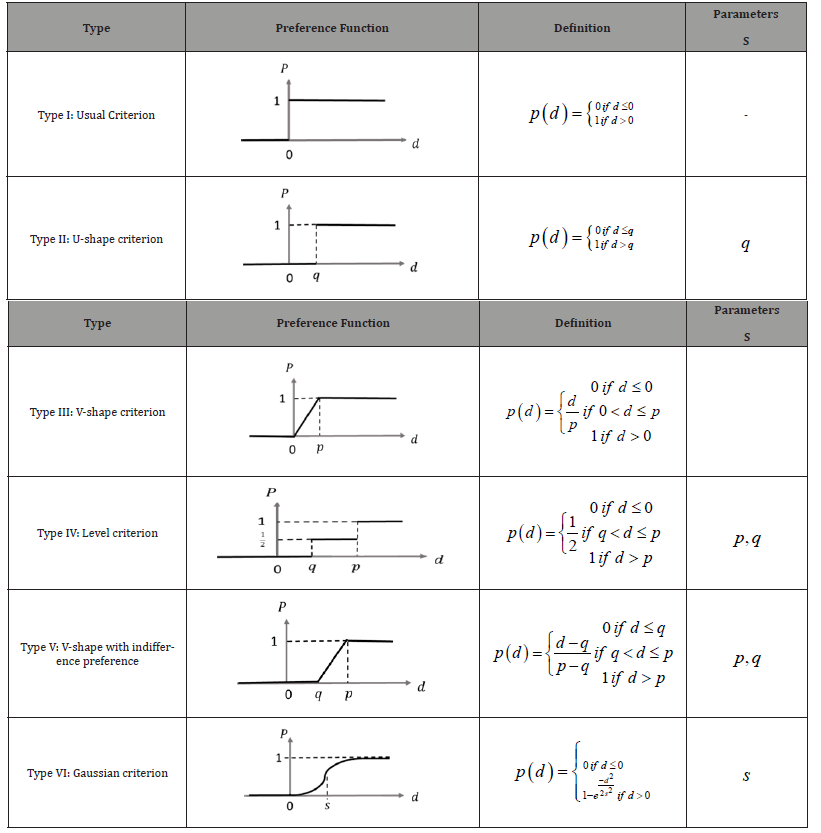
In Table 3, three threshold values are defined as p, q , and s which are strict preference threshold, indifference threshold, and an intermediate value between q , and ; respectively. The six functions listed in Table 3 are between commonly used types, but additional generalized criteria can be also considered.
Step 2: Determining the Aggregated Preference Indices
After providing the evaluation values of the alternatives for each criterion, the weights, and the generalized criteria, the aggregated preference indices and outranking flows should be determined in this step. For this, the following equation can be applied:
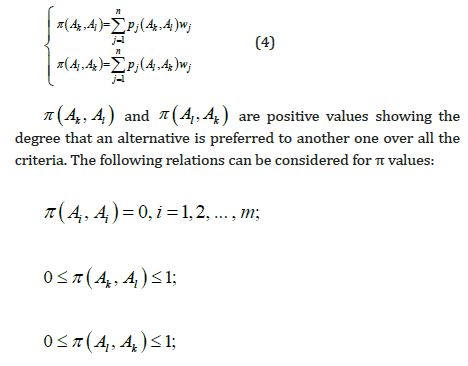
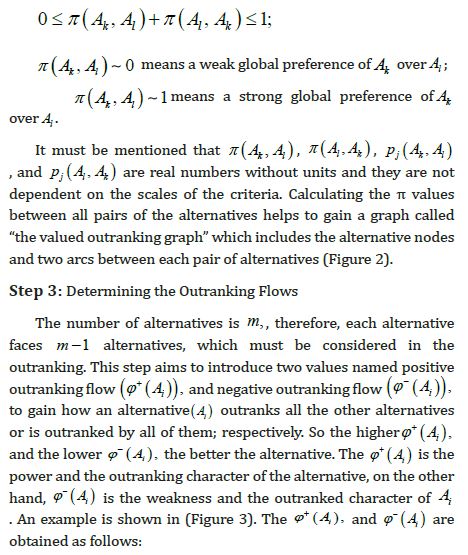


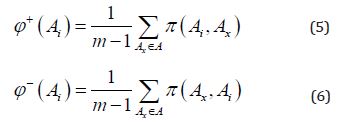
After determining the positive and negative outranking flows, the relations of the pairs of alternatives can be determined using the following step.
Step 4: Obtaining the Partial Outranking
In this step, the positive and negative outranking flows are used to determine the partial outranking as the result of the PROMETHEE I method. As the same rankings are not induced by both flows, the PROMETHEE I uses the following relations (Equation 7) to determine the preference, indifference, and incomparability of the alternatives:
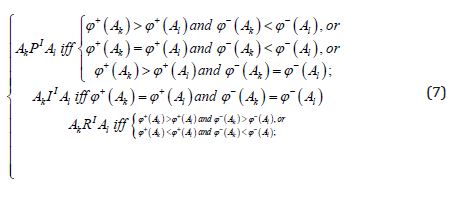
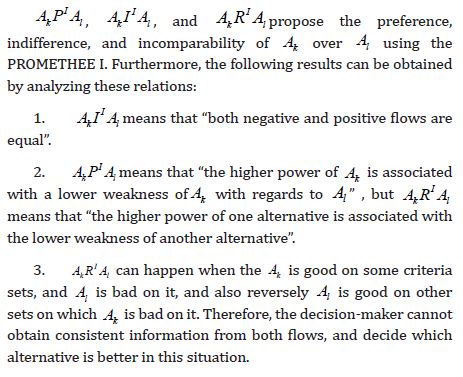
4. This method gives a classification of the various alternatives to the decision-makers.
5. This method is not able to classify all the alternatives, and some alternatives can remain incomparable.
PROMETHEE II Method (Complete Ranking)
To eliminate the limits of the PROMETHEE I related to choosing the better alternative in some cases, the PROMETHEE II was developed based on introducing a net outranking flow. The first three steps of the PROMETHEE II are similar to the former method, but the outranking step is different as it includes obtaining the net outranking flow as a balance between negative and positive flows using the following equation:
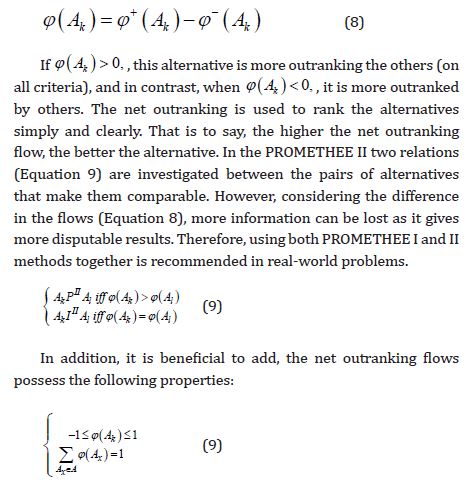
Finally, this method gives a simple and clear way to gain a complete rank for the alternatives [6,11-14].
Conclusion
In conclusion, this paper’s survey sheds light on the concept of the PROMETHEE method, its usefulness in different application areas, and the advantages and disadvantages of using this method. The process steps of both the partial and complete ranking by the PROMETHEE method were carefully described, highlighting their similarities and differences. While both methods have an easyto- understand structure, the PROMETHEE II method’s use of net outranking flows in the final outranking step provides a more precise rank between the alternatives, making it easier to select the best option. Ultimately, understanding the PROMETHEE method and its various applications can aid decision-makers in making more informed decisions by providing them with a systematic and objective approach to assessing multiple criteria alternatives.
To read more about this article...Open Access Journal of Economics & Business Management
Please follow the URL to access more information about this article
To know more about our Journals...Iris Publishers
To know more about Open Access Publishers





No comments:
Post a Comment